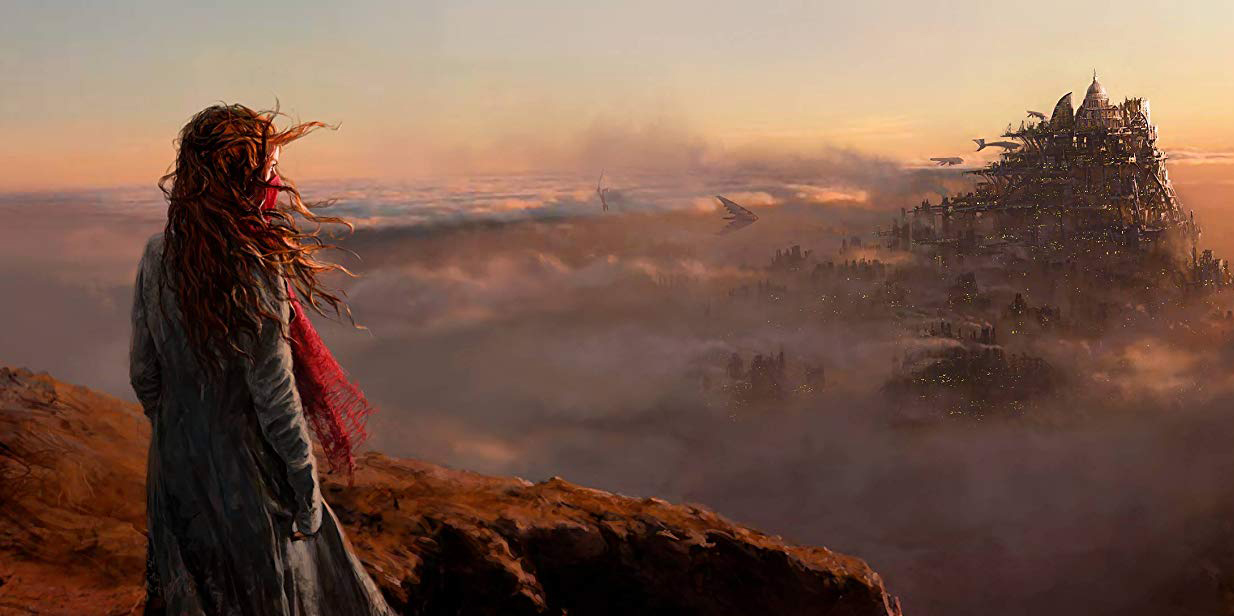Mortal Engines Review

Mortal Engines is an exciting prospect. Combining the dreamlike flying-machines and detail of Studio Ghibli’s most fantastical fare with a steampunk environment and a scale that even Lord of the Rings’ Peter Jackson (producing here) would be impressed with, Mortal Engines truly could have it all – but it may be too much. Akin to the small village vehicle that’s gobbled up at the start, the film is too heavy to move so fast so soon. Unwieldy, busy and lacking the charm that a first-film desperately needs to hook in an audience, the wildly ambitious movie chugs along and spits and splutters to its final conclusion.
Set in a grimy dystopia, Earth as we know it came to an end during the Sixty Minute War. In this particular era, though dirty Minion models and broken iPhones can be found deep beneath the rubble, only enormous moving vehicles, that house hundreds (thousands?) of inhabitants, roam the world and out-match each other. In a thrilling opening, we see “London”, a monster of a machine, take out a Howl’s Moving Castle town-on-wheels before offering asylum to the homeless left by its destruction. Among those on board the small town are Hester Shaw (Hera Hilmar), a mysterious girl who hides her face and has a different plan of action. Onboard “London”, on the other hand, is Tom Natsworthy (Misfits Robert Sheehan), a naive outcast who dreamed of aviation but found himself becoming a historian. Villainous Thaddeus Valentine (Hugo Weaving) brings the two unexpectedly together and sets them off on a course that will change their fate forever. Inevitably, Brexit and British arrogance looms large over Mortal Engines. Lines that openly acknowledge a disrespect towards Europe and, despite clearly disastrous consequences, leaders that refuse to budge on their view on where “London” should go (“stay the course”, they bellow as it is clear that danger lurks ahead) force an immediate comparison. Indeed, when you emblazon a union jack on the side of the villain’s mode of transport, the head-bangingly obvious parallels have to be made. Historically, the “British villain” has often been a go-to cliché for filmmakers but Mortal Engines goes one step further and criticises the society too. Crowds gather to see the destruction of a smaller community, clamouring over the sides to see the loss of others as they cheer and enjoy their dominance. There is an accepted class-system, where your upbringing will place you on a particular tier. The top tier for the elite upper-class and then the rabble down below who have to queue to even get through the barriers at a vertically-moving Tottenham Court Station. A brief appearance by Colin Salmon, as Pomeroy, seems to exist as a means to highlight how some of the Londoners are less than accepting of the society that has been created.
Inevitably, Brexit and British arrogance looms large over Mortal Engines. Lines that openly acknowledge a disrespect towards Europe and, despite clearly disastrous consequences, leaders that refuse to budge on their view on where “London” should go (“stay the course”, they bellow as it is clear that danger lurks ahead) force an immediate comparison. Indeed, when you emblazon a union jack on the side of the villain’s mode of transport, the head-bangingly obvious parallels have to be made. Historically, the “British villain” has often been a go-to cliché for filmmakers but Mortal Engines goes one step further and criticises the society too. Crowds gather to see the destruction of a smaller community, clamouring over the sides to see the loss of others as they cheer and enjoy their dominance. There is an accepted class-system, where your upbringing will place you on a particular tier. The top tier for the elite upper-class and then the rabble down below who have to queue to even get through the barriers at a vertically-moving Tottenham Court Station. A brief appearance by Colin Salmon, as Pomeroy, seems to exist as a means to highlight how some of the Londoners are less than accepting of the society that has been created.
But, as unapologetically critical as Mortal Instruments may be, it clouds any apparent subtext with a tiresome out-of-date story that fails to capture the energy and imagination that the world could potentially offer. Amidst the two heroes who have a primary goal to kill Valentine, we are also presented with a Terminator-clone hunter who, though complex and memorable, seems wholly extraneous and simply slows the film down. We are also introduced to a supporting crew of sky-dwellers (who fly ships akin to the pirates in Ghibli’s Laputa: Castle in the Sky and Nausicaa: In The Valley of the Wind) but, for the most part, they are squeezed out of the story soon after.
If this was the final part of a series, the many characters may hold a significance that we could latch onto. When one hero appears, pinched straight from The Matrix trilogy, we are left confused: are we supposed to know her? Is she a friend or foe? Mortal Engines may be cinematic and sprawling but without engaging characters and a solid story, it becomes a cacophony of discordant excess.
★★


